Distribution Characteristics and Source Apportionment of Winter Carbonaceous Aerosols in a Rural Area in Shandong, China
Abstract
1. Introduction
2. Material and Methods
2.1. Sampling Site
2.2. Sample Collection
2.3. The Determination of Chemical Components in PM2.5
2.3.1. Determination of Carbon Fractions
2.3.2. Determination of WSOC and MSOC
2.3.3. Determination of Water-Soluble Ions
2.4. Minimum R Squared (MRS) Method
2.5. Backward Trajectory Model (HYSPLIT)
2.6. Positive Matrix Factorisation (PMF)
3. Results and Discussion
3.1. Distribution Characteristics of PM2.5
3.2. Distribution Characteristics of Carbon Components in PM2.5
3.2.1. OC and EC
3.2.2. SOC
3.2.3. Eight Carbon Fractions
3.2.4. WSOC and MSOC
3.3. Distribution Characteristics of Water-Soluble Ions in PM2.5
3.3.1. Concentrations and Proportions of Cations and Anions
3.3.2. Analysis of the Combination Form of Anion and Cation
3.3.3. Analysis of the Formation of Secondary Ions
3.4. Source Apportionment of PM2.5
3.4.1. Source Apportionment Based on the Ratios of Some Typical Components
- Based on the ratios of OC/EC and char/soot
- 2.
- Based on the ratios of different ions
3.4.2. Source Apportionment Based on HYSPLIT Model
3.4.3. Source Apportionment Based on the PMF Model
4. Conclusions
Author Contributions
Funding
Institutional Review Board Statement
Informed Consent Statement
Data Availability Statement
Conflicts of Interest
References
- Zhang, Y.M.; Zhang, X.Y.; Zhong, J.T.; Sun, J.Y.; Shen, X.J.; Zhang, Z.X.; Xu, W.Y.; Liang, L.L.; Liu, Y.S.; Hu, X.Y.; et al. On the fossil and non-fossil fuel sources of carbonaceous aerosol with radiocarbon and AMS-PMF methods during winter hazy days in a rural area of North China plain. Environ. Res. 2022, 208, 112672. [Google Scholar] [CrossRef] [PubMed]
- Pyta, H.; Rogula-Kozłowska, W.; Mathews, B. Co-occurrence of PM2.5-bound mercury and carbon in rural areas affected by coal combustion. Atmos. Pollut. Res. 2017, 8, 127–135. [Google Scholar] [CrossRef]
- Yin, L.Q.; Niu, Z.C.; Chen, X.Q.; Chen, J.S.; Xu, L.L.; Zhang, F.W. Chemical compositions of PM2.5 aerosol during haze periods in the mountainous city of Yong’an, China. J. Environ. Sci. 2012, 24, 1225–1233. [Google Scholar] [CrossRef]
- Cao, J.J.; Shen, Z.X.; Chow, J.C.; Watson, J.G.; Lee, S.C.; Tie, X.X.; Ho, K.F.; Wang, G.H.; Han, Y.M. Winter and summer PM2.5 chemical compositions in fourteen Chinese cities. J. Air Waste Manag. Assoc. 2012, 62, 1214–1226. [Google Scholar] [CrossRef] [PubMed]
- Liu, P.; Zhang, C.; Xue, C.; Mu, Y.J.; Liu, J.F.; Zhan, Y.Y.; Tian, D.; Ye, C.; Zhang, H.X.; Guan, J. The contribution of residential coal combustion to atmospheric PM2.5 in northern China during winter. Atmos. Chem. Phys. 2017, 17, 11503–11520. [Google Scholar] [CrossRef]
- Shi, H.B.; Huang, Y.; Chen, X.; Li, T.; He, M.; Wang, J.J. Pollution characteristics and source apportionment of carbon components in PM2.5 in winter in Chengdu. J. Ecol. Environ. 2021, 30, 1420–1427. [Google Scholar]
- Central Meteorological Station. 24-Hour Live Curve [EB/OL]. Available online: http://www.nmc.cn/ (accessed on 5 April 2022).
- Han, Y.M.; Han, Z.W.; Cao, J.J.; Chow, J.C.; Watson, J.G.; An, Z.S.; Liu, S.X.; Zhang, R.J. Distribution and origin of carbonaceous aerosol over a rural high-mountain lake area, Northern China and its transport significance. Atmos. Environ. 2008, 42, 2405–2414. [Google Scholar] [CrossRef]
- Han, Y.M.; Cao, J.J.; Chow, J.C.; Watson, J.G.; An, Z.S.; Jin, Z.D.; Fung, K.; Liu, S.X. Evaluation of the thermal/optical reflectance method for discrimination between char- and soot-EC. Chemosphere 2007, 69, 569–574. [Google Scholar] [CrossRef]
- Wu, C.; Yu, J.Z. Determination of primary combustion source organic carbon-to-elemental carbon (OC/EC) ratio using ambient OC and EC measurements: Secondary OC-EC correlation minimization method. Atmos. Chem. Phys. 2016, 16, 5453–5465. [Google Scholar] [CrossRef]
- Stein, A.F.; Draxler, R.R.; Rolph, G.D.; Stunder, B.J.B.; Cohen, M.D.; Ngan, F. NOAA’s HYSPLIT Atmospheric Transport and Dispersion Modeling System. Bull. Am. Meteorol. Soc. 2015, 96, 2059–2077. [Google Scholar] [CrossRef]
- Liu, B.S.; Wu, J.H.; Zhang, J.Y.; Wang, L.; Yang, J.M.; Liang, D.N.; Dai, Q.L.; Bi, X.H.; Feng, Y.C.; Zhang, Y.F.; et al. Characterization and source apportionment of PM2.5 based on error estimation from EPA PMF 5. 0 model at a medium city in China. Environ. Pollut. 2017, 222, 10–22. [Google Scholar] [CrossRef] [PubMed]
- Benchrif, A.; Tahri, M.; Guinot, B.; Chakir, E.M.; Zahry, F.; Bagdhad, B.; Bounakhla, M.; Cachier, H.; Costabile, F. Aerosols in Northern Morocco-2: Chemical Characterization and PMF Source Apportionment of Ambient PM2.5. Atmosphere 2022, 13, 1701. [Google Scholar] [CrossRef]
- Wang, H.L.; Miao, Q.; Shen, L.J.; Yang, Q.; Wu, Y.Z.; Wei, H. Air pollutant variations in Suzhou during the 2019 novel coronavirus (COVID-19) lockdown of 2020: High time-resolution measurements of aerosol chemical compositions and source apportionment. Environ. Pollut. 2021, 271, 116298. [Google Scholar] [CrossRef] [PubMed]
- Louie PK, K.; Watson, J.G.; Chow, J.C.; Chen, A.; Sin, D.W.M.; Lau, A.K.H. Seasonal characteristics and regional transport of PM2. 5 in Hong Kong. Atmos. Environ. 2005, 39, 1695–1710. [Google Scholar]
- Meng, Z.Y.; Wu, L.Y.; Xu, X.D.; Xu, W.Y.; Zhang, R.J.; Jia, X.F.; Liang, L.L.; Miao, Y.C.; Cheng, H.B.; Xie, Y.L.; et al. Changes in ammonia and its effects on PM2.5 chemical property in three winter seasons in Beijing, China. Sci. Total Environ. 2020, 749, 142208. [Google Scholar] [CrossRef]
- Xu, L.L.; Chen, X.Q.; Chen, J.S.; Zhang, F.W.; He, C.; Zhao, J.P.; Yin, L.Q. Seasonal variations and chemical compositions of PM2.5 aerosol in the urban area of Fuzhou, China. Atmos. Res. 2012, 104–105, 264–272. [Google Scholar] [CrossRef]
- Tian, Y.Z.; Wang, J.; Peng, X.; Shi, G.L.; Feng, Y.C. Estimation of the direct and indirect impacts of fireworks on the physicochemical characteristics of atmospheric PM10 and PM2.5. Atmos. Chem. Phys. 2014, 14, 9469–9479. [Google Scholar] [CrossRef]
- Mikuška, P.; Křůmal, K.; Večeřa, Z. Characterization of organic compounds in the PM2.5 aerosols in winter in an industrial urban area. Atmos. Environmen. 2015, 105, 97–108. [Google Scholar] [CrossRef]
- Zhang, X.X.; Xu, H.D.; Liang, D. Spatiotemporal variations and connections of single and multiple meteorological factors on PM2.5 concentrations in Xi’an, China. Atmos. Environ. 2022, 275, 119015. [Google Scholar] [CrossRef]
- Xu, Y.L.; Xue, W.B.; Lei, Y.; Zhao, Y.; Cheng, S.Y.; Ren, Z.H.; Huang, Q. Impact of Meteorological Conditions on PM2.5 Pollution in China during Winter. Atmosphere 2018, 9, 429. [Google Scholar] [CrossRef]
- Wu, C.; Wu, D.; Yu, J.Z. Estimation and Uncertainty Analysis of Secondary Organic Carbon Using 1Year of Hourly Organic and Elemental Carbon Data. J. Geophys. Res. Atmos. 2019, 124, 2774–2795. [Google Scholar] [CrossRef]
- Hu, W.W.; Hu, M.; Deng, Z.Q.; Xiao, R.; Kondo, Y.; Takegawa, N.; Zhao, Y.J.; Guo, S.; Zhang, Y.H. The characteristics and origins of carbonaceous aerosol at a rural site of PRD in summer of 2006. Atmos. Chem. Phys. 2012, 12, 1811–1822. [Google Scholar] [CrossRef]
- Xu, J.; Wang, Q.Z.; Deng, C.R.; McNeill, V.F.; Fankhauser, A.; Wang, F.W.; Zheng, X.J.; Shen, J.D.; Huang, K.; Zhuang, G.S. Insights into the characteristics and sources of primary and secondary organic carbon: High time resolution observation in urban Shanghai. Environ. Pollut. 2018, 233, 1177–1187. [Google Scholar] [CrossRef]
- Izhar, S.; Gupta, T.; Panday, A.K. Improved method to apportion optical absorption by black and brown carbon under the influence of haze and fog at Lumbini, Nepal, on the Indo-Gangetic Plains. Environ. Pollut. 2020, 263, 114640. [Google Scholar] [CrossRef]
- Yan, C.Q.; Zheng, M.; Bosch, C.; Andersson, A.; Desyaterik, Y.; Sullivan, A.P.; Collett, J.L.; Zhao, B.; Wang, S.X.; He, K.B.; et al. Important fossil source contribution to brown carbon in Beijing during winter. Sci. Rep. 2017, 7, 43182. [Google Scholar] [CrossRef] [PubMed]
- Martinsson, J.; Eriksson, A.C.; Nielsen, I.E.; Malmborg, V.B.; Ahlberg, E.; Andersen, C.; Lindgren, R.; Nyström, R.; Nordin, E.Z.; Brune, W.H.; et al. Impacts of Combustion Conditions and Photochemical Processing on the Light Absorption of Biomass Combustion Aerosol. Environ. Sci. Technol. 2015, 49, 14663–14671. [Google Scholar] [CrossRef] [PubMed]
- Cheng, Y.; He, K.B.; Du, Z.Y.; Engling, G.; Liu, J.M.; Ma, Y.L.; Zheng, M.; Weber, R.J. The characteristics of brown carbon aerosol during winter in Beijing. Atmos. Environ. 2016, 127, 355–364. [Google Scholar] [CrossRef]
- Wu, G.M.; Ram, K.; Fu, P.Q.; Wang, W.; Zhang, Y.L.; Liu, X.Y.; Stone, E.A.; Pradhan, B.B.; Dangol, P.M.; Panday, A.; et al. Water-Soluble Brown Carbon in Atmospheric Aerosols from Godavari (Nepal), a Regional Representative of South Asia. Environ. Sci. Technol. 2019, 53, 3471–3479. [Google Scholar] [CrossRef]
- Chen, P. Light absorption properties of elemental carbon (EC) and water-soluble brown carbon (WS-BrC) in the Kathmandu Valley, Nepal: A 5-year study. Environ. Pollut. 2020, 261, 114239. [Google Scholar] [CrossRef]
- Wang, T.; Li, D.; Xue, S.P.; Wang, Y.S. Light absorption characteristics and source apportionment of multiphase particles of brown carbonaceous aerosol in Xi’an winter. J. Eng. Thermophys. 2021, 42, 2010–2016. [Google Scholar]
- Tan, J.H.; Duan, J.C.; Zhen, N.J.; He, K.B.; Hao, J.M. Chemical characteristics and source of size-fractionated atmospheric particle in haze episode in Beijing. Atmos. Res. 2016, 167, 24–33. [Google Scholar] [CrossRef]
- He, Q.S.; Yan, Y.L.; Guo, L.L.; Zhang, Y.L.; Zhang, G.X.; Wang, X.M. Characterization and source analysis of water-soluble inorganic ionic species in PM2.5 in Taiyuan city, China. Atmos. Res. 2017, 184, 48–55. [Google Scholar] [CrossRef]
- Dai, W.; Gao, J.Q.; Cao, G.; Feng, O.Y. Chemical composition and source identification of PM2.5 in the suburb of Shenzhen, China. Atmos. Res. 2013, 122, 391–400. [Google Scholar] [CrossRef]
- Li, H.; Tang, G.Q.; Zhang, J.K.; Liu, Q.; Yan, G.X.; Chen, M.T.; Gao, W.K.; Wang, Y.H.; Wang, Y.S. Characteristics of water-soluble inorganic ions in atmospheric PM2.5 in Beijing from 2017 to 2018. Environ. Sci. 2020, 41, 4364–4373. [Google Scholar]
- Yang, L.M.; Wang, S.B.; Hao, Q.; Han, S.J.; Li, C.; Zhao, Q.Y.; Yan, Q.S.; Zhang, R.Q. Characteristics and source analysis of water-soluble ions in PM2.5 in Zhengzhou. Environ. Sci. 2019, 40, 2977–2984. [Google Scholar]
- Cheng, C.; Shi, M.M.; Liu, W.J.; Mao, Y.; Hu, J.X.; Tian, Q.; Chen, Z.L.; Hu, T.P.; Xing, X.L.; Qi, S.H. Characteristics and source apportionment of water-soluble inorganic ions in PM2. 5 during a wintertime haze event in Huanggang, central China. Atmos. Pollut. Res. 2021, 12, 111–123. [Google Scholar] [CrossRef]
- Zhang, L.; Vet, R.; Wiebe, A.; Mihele, C.; Sukloff, B.; Chan, E.; Moran, M.D.; Iqbal, S. Characterization of the size-segregated water-soluble inorganic ions at eight Canadian rural sites. Atmos. Chem. Phys. 2008, 8, 7133–7151. [Google Scholar] [CrossRef]
- Zheng, B.; Zhang, Q.; Zhang, Y.; He, K.B.; Wang, K.; Zheng, G.J.; Duan, F.K.; Ma, Y.L.; Kimoto, T. Heterogeneous chemistry: A mechanism missing in current models to explain secondary inorganic aerosol formation during the January 2013 haze episode in North China. Atmos. Chem. Phys. 2015, 15, 2031–2049. [Google Scholar] [CrossRef]
- Meng, C.C.; Wang, L.T.; Zhang, F.F.; Wei, Z.; Ma, S.M.; Ma, X.; Yang, J. Characteristics of concentrations and water-soluble inorganic ions in PM2.5 in Handan City, Hebei province, China. Atmos. Res. 2016, 171, 133–146. [Google Scholar] [CrossRef]
- Liu, K.; Ren, J. Seasonal characteristics of PM2.5 and its chemical species in the northern rural China. Atmos. Pollut. Res. 2020, 11, 1891–1901. [Google Scholar] [CrossRef]
- Gržinić, G.; Bartels-Rausch, T.; Berkemeier, T.; Türler, A.; Ammann, M. Viscosity controls humidity dependence of N2O5 uptake to citric acid aerosol. Atmos. Chem. Phys. 2015, 15, 13615–13625. [Google Scholar] [CrossRef]
- Wang, X.F.; Wang, H.; Xue, L.K.; Wang, T.; Wang, L.W.; Gu, R.R.; Wang, W.H.; Tham, Y.J.; Wang, Z.; Yang, L.X.; et al. Observations of N2O5 and ClNO2 at a polluted urban surface site in North China: High N2O5 uptake coefficients and low ClNO2 product yields. Atmos. Environ. 2017, 156, 125–134. [Google Scholar] [CrossRef]
- McDuffie, E.E.; Fibiger, D.L.; Dubé, W.P.; Felipe, L.H.; Lee, B.H.; Thornton, J.A.; Shah, V.; Jaeglé, L.; Guo, H.Y.; Weber, R.J.; et al. Heterogeneous N2O5 uptake during winter: Aircraft measurements during the 2015 WINTER campaign and critical evaluation of current parameterizations. J. Geophys. Res. Atmos. 2018, 123, 4345–4372. [Google Scholar] [CrossRef]
- Chen, Y.J.; Sheng, G.Y.; Bi, X.H.; Feng, Y.L.; Mai, B.X.; Fu, J.M. Emission factors for carbonaceous particles and polycyclic aromatic hydrocarbons from residential coal combustion in China. Environ. Sci. Technol. 2005, 39, 1861–1867. [Google Scholar] [CrossRef]
- Zhang, Y.X.; Shao, M.; Zhang, Y.H.; Zeng, L.M.; He, L.Y.; Zhu, B.; Wei, Y.J.; Zhu, X.L. Source profiles of particulate organic matters emitted from cereal straw burnings. J. Environ. Sci. 2007, 19, 167–175. [Google Scholar] [CrossRef]
- Pio, C.; Cerqueira, M.; Harrison, R.M.; Nunes, T.; Mirante, F.; Alves, C.; Oliveira, C.; Campa, A.S.; Artíñano, B.; Matos, M. OC/EC ratio observations in Europe: Re-thinking the approach for apportionment between primary and secondary organic carbon. Atmos. Environ. 2011, 45, 6121–6232. [Google Scholar] [CrossRef]
- Huang, H.; Ho, K.F.; Lee, S.C.; Tsang, P.K.; Ho, S.S.H.; Zou, C.W.; Zou, S.C.; Cao, J.J.; Xu, H.M. Characteristics of carbonaceous aerosol in PM2.5: Pearl Delta River Region, China. Atmos. Res. 2012, 104–105, 227–236. [Google Scholar] [CrossRef]
- Wang, F.W.; Feng, T.; Guo, Z.G.; Li, Y.Y.; Lin, T.; Rose, N.L. Sources and dry deposition of carbonaceous aerosols over the coastal East China Sea: Implications for anthropogenic pollutant pathways and deposition. Environ. Pollut. 2019, 245, 771–779. [Google Scholar] [CrossRef]
- Chow, J.C.; Watson, J.G.; Kuhns, H.; Etyemezian, V.; Lowenthal, D.H.; Crow, D.; Kohl, S.D.; Engelbrecht, J.P.; Green, M.C. Source profiles for industrial, mobile, and area sources in the Big Bend Regional Aerosol Visibility and Observational study. Chemosphere 2004, 54, 185–208. [Google Scholar] [CrossRef]
- Cao, J.; Lee, S.; Ho, K.; Fung, K.; Chow, J.C.; Watson, J.G. Characterization of roadside fine particulate carbon and its eight fractions in Hong Kong. Aerosol Air Qual. Res. 2006, 6, 106–122. [Google Scholar] [CrossRef]
- Cao, J.J.; Wu, F.; Chow, J.C.; Lee, S.C.; Li, Y.; Chen, S.W.; An, Z.S.; Fung, K.K.; Watson, J.G.; Zhu, C.S.; et al. Characterization and source apportionment of atmospheric organic and elemental carbon during fall and winter of 2003 in Xi’an, China. Atmos. Chem. Phys. 2005, 5, 3127–3137. [Google Scholar] [CrossRef]
- Shen, Z.X.; Cao, J.J.; Arimoto, R.; Han, Z.W.; Zhang, R.J.; Han, Y.M.; Liu, S.X.; Okuda, T.; Naka, S.; Tanaka, S. Ionic composition of TSP and PM2.5 during dust storms and air pollution episodes at Xi’an, China. Atmos. Environ. 2009, 43, 2911–2918. [Google Scholar] [CrossRef]
- Wang, H.J.; Wang, X.H.; Zhou, H.J.; Ma, H.; Xie, F.; Zhou, X.J.; Fan, Q.Y.; Lü, C.W.; He, J. Stoichiometric characteristics and economic implications of water-soluble ions in PM2.5 from a resource-dependent city. Environ. Res. 2021, 193, 110522. [Google Scholar] [CrossRef] [PubMed]
- Mu, L.; Zheng, L.; Liang, M.; Tian, M.; Li, X.; Jing, D. Characterization and Source Analysis of Water-soluble Ions in Atmospheric Particles in Jinzhong, China. Aerosol Air Qual. Res. 2019, 19, 2396–2409. [Google Scholar] [CrossRef]
- Xu, M.J.; Wang, Y.H.; Tang, L.L.; Zhang, X.Z.; Tang, L.; Li, X.W.; Cui, Y.X.; Cheng, M.N. Characteristics of water-soluble ions in PM10 in urban and suburban Nanjing in autumn. Environ. Eng. 2012, 30, 108–113. [Google Scholar]
- Park, S.S.; Sim, S.Y.; Bae, M.S.; Schauer, J.J. Size distribution of water-soluble components in particulate matter emitted from biomass burning. Atmos. Environ. 2013, 73, 62–72. [Google Scholar] [CrossRef]

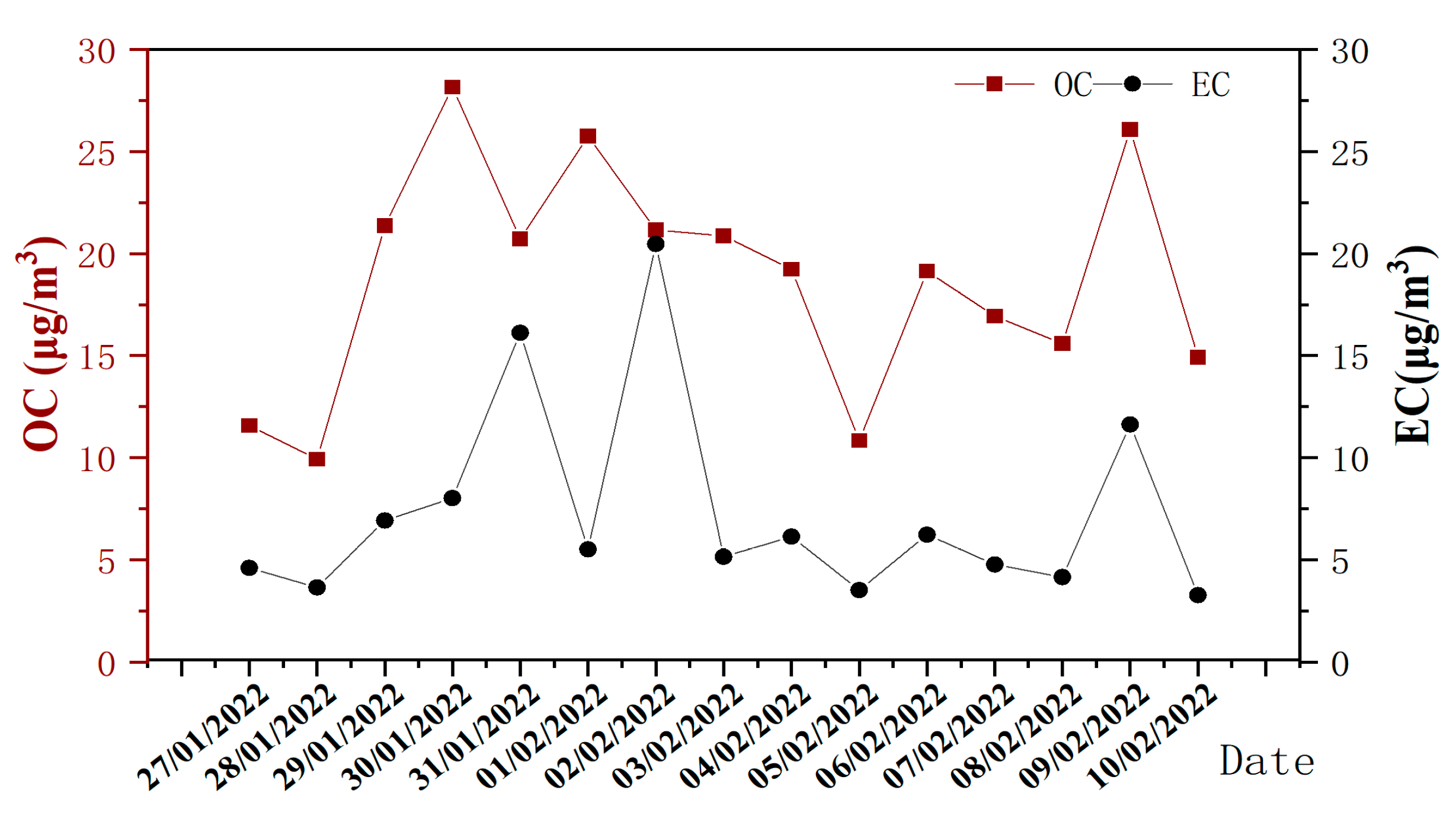
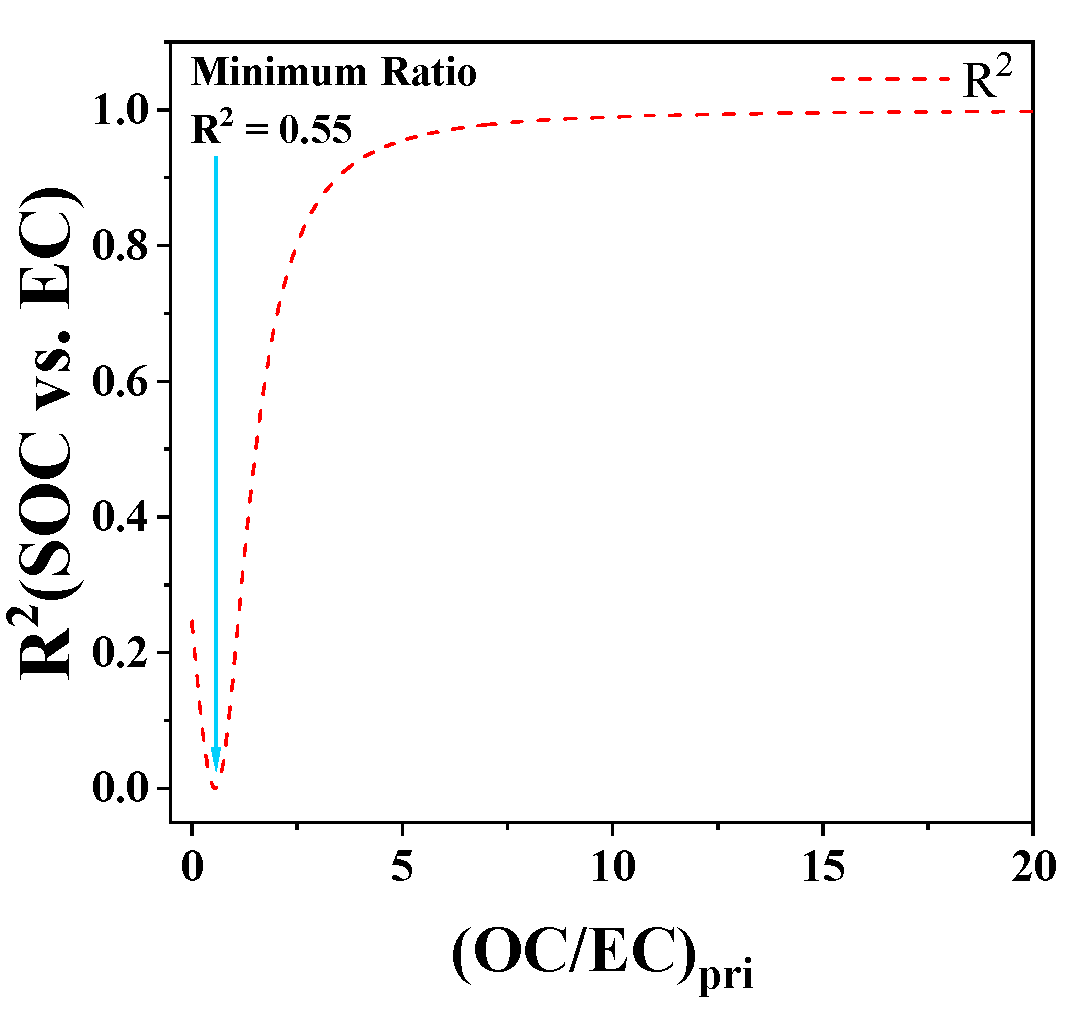
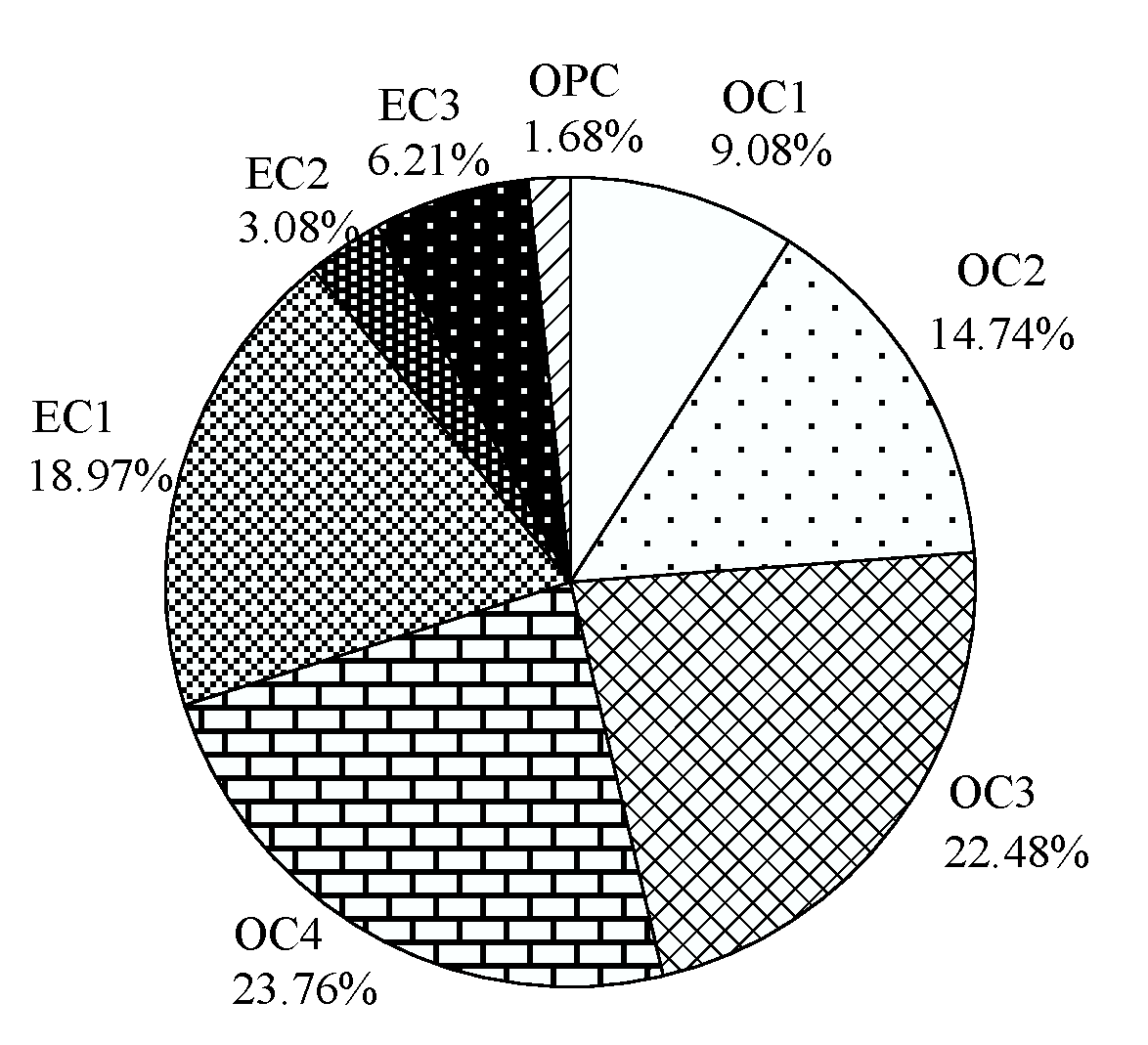
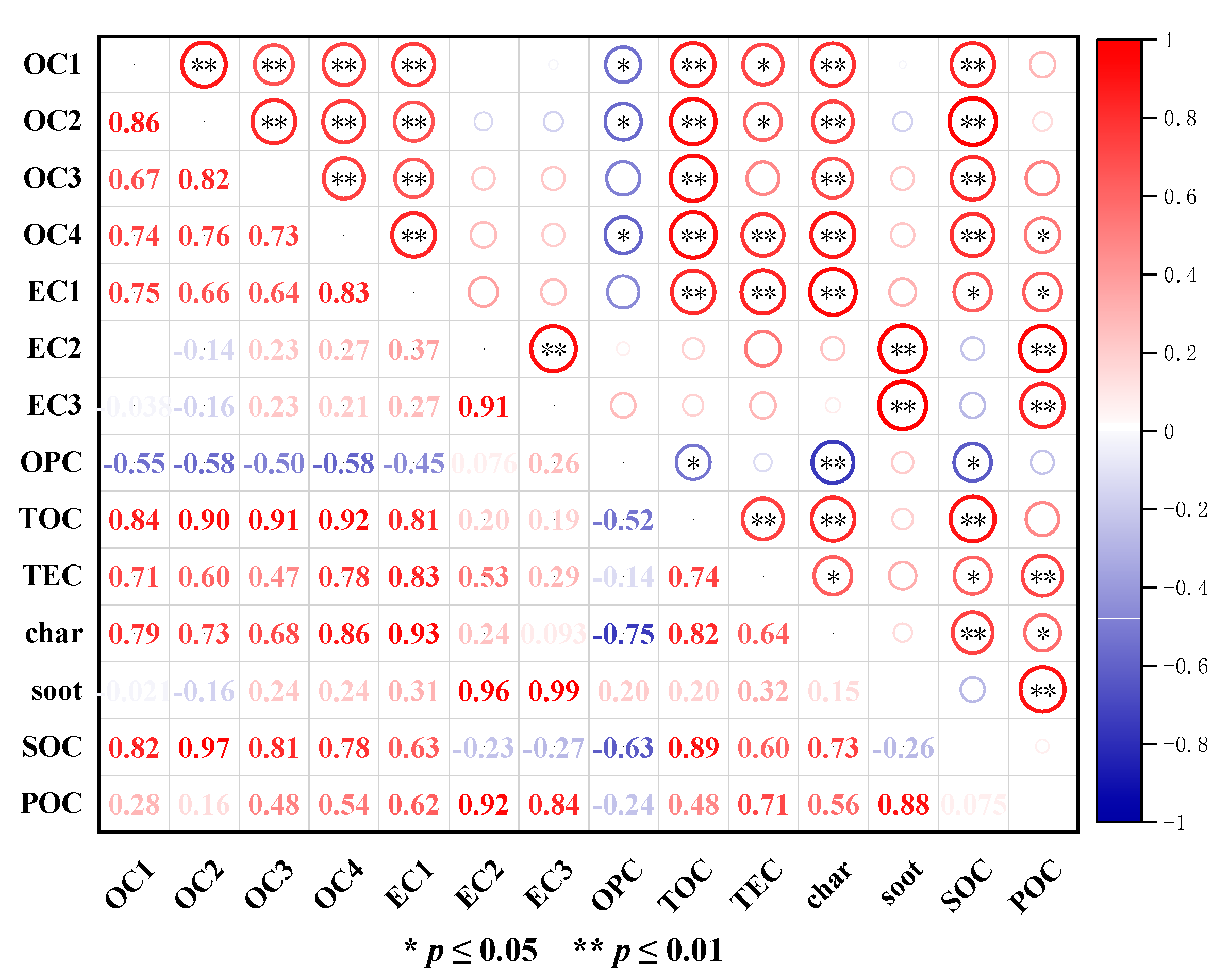
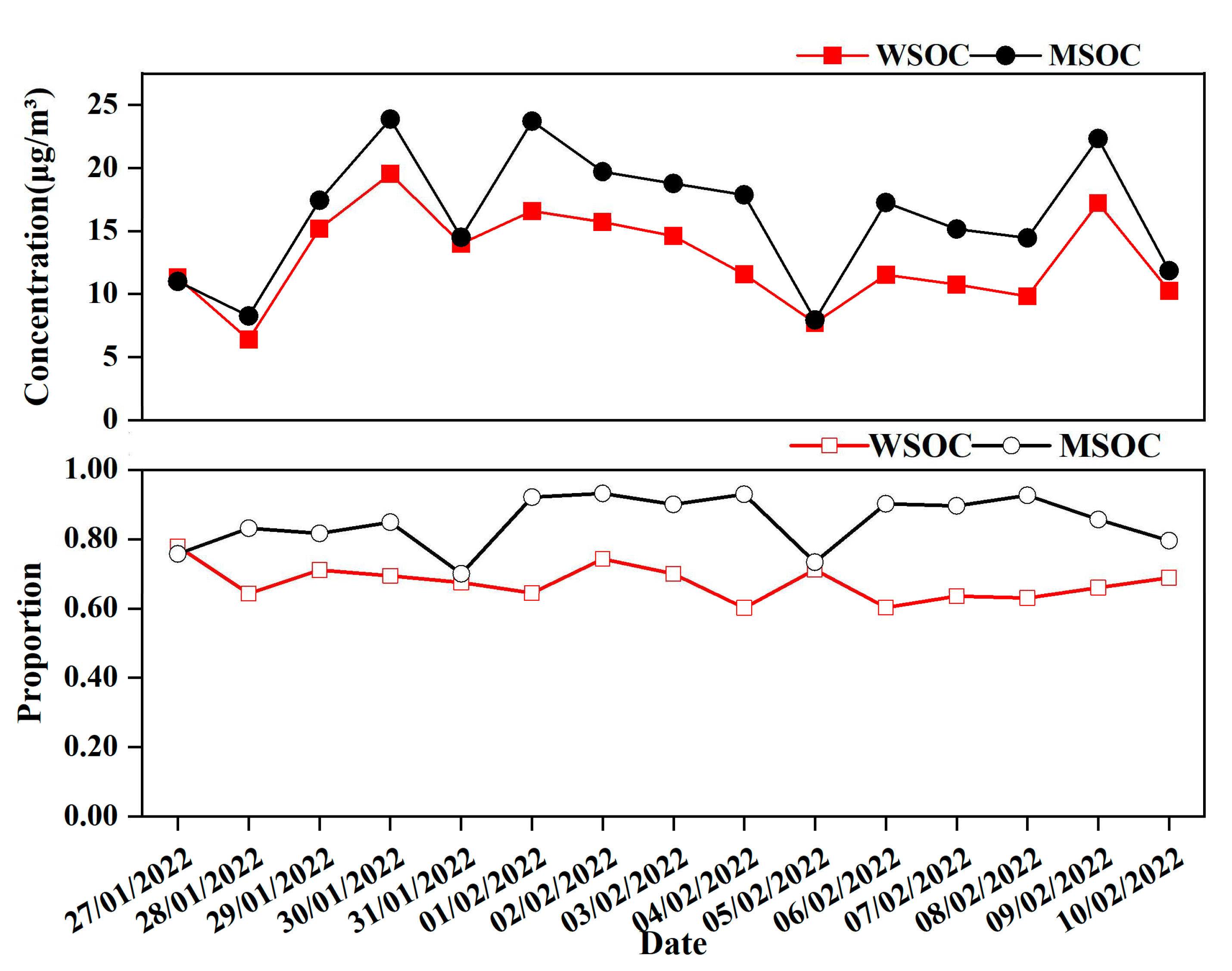
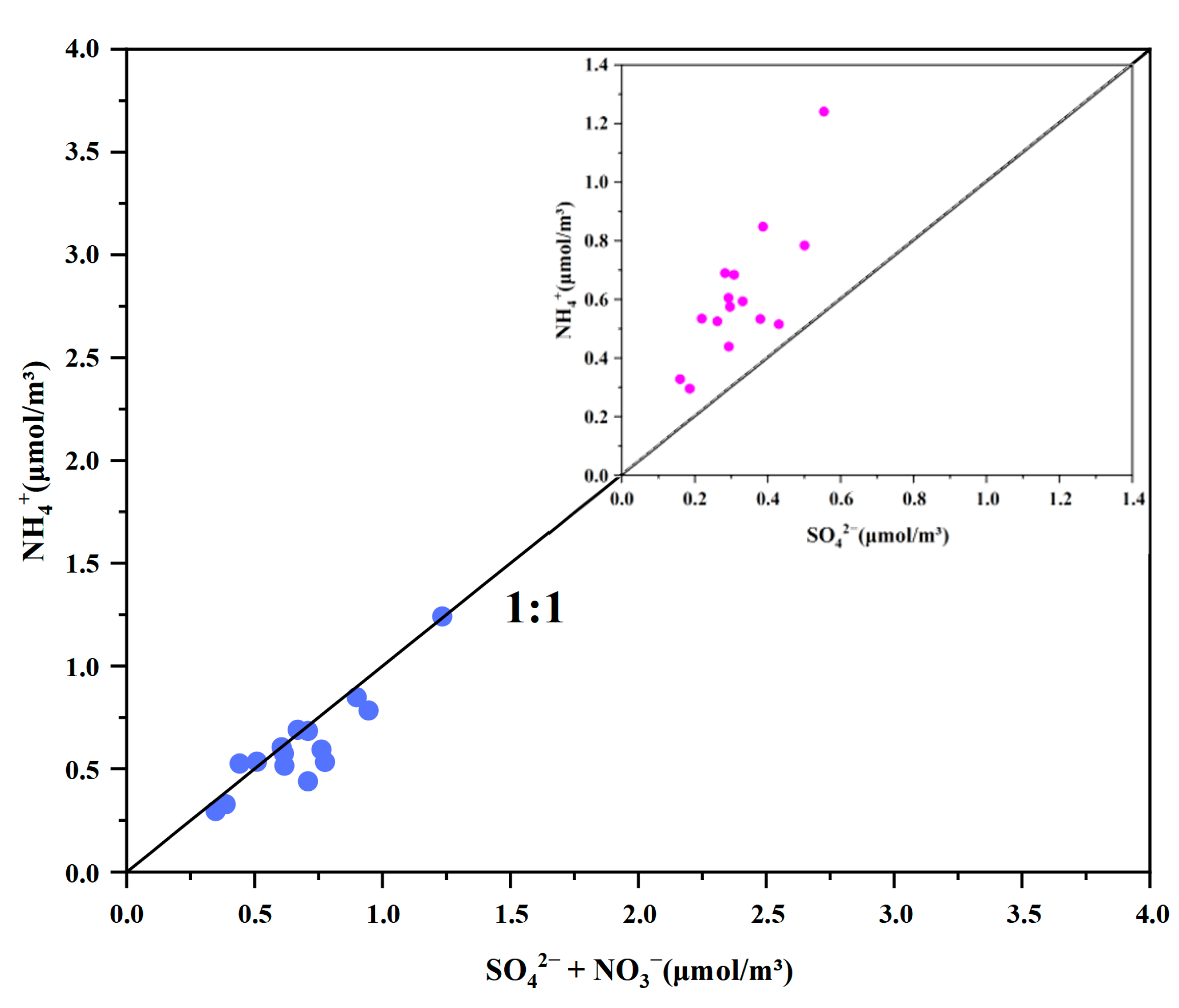
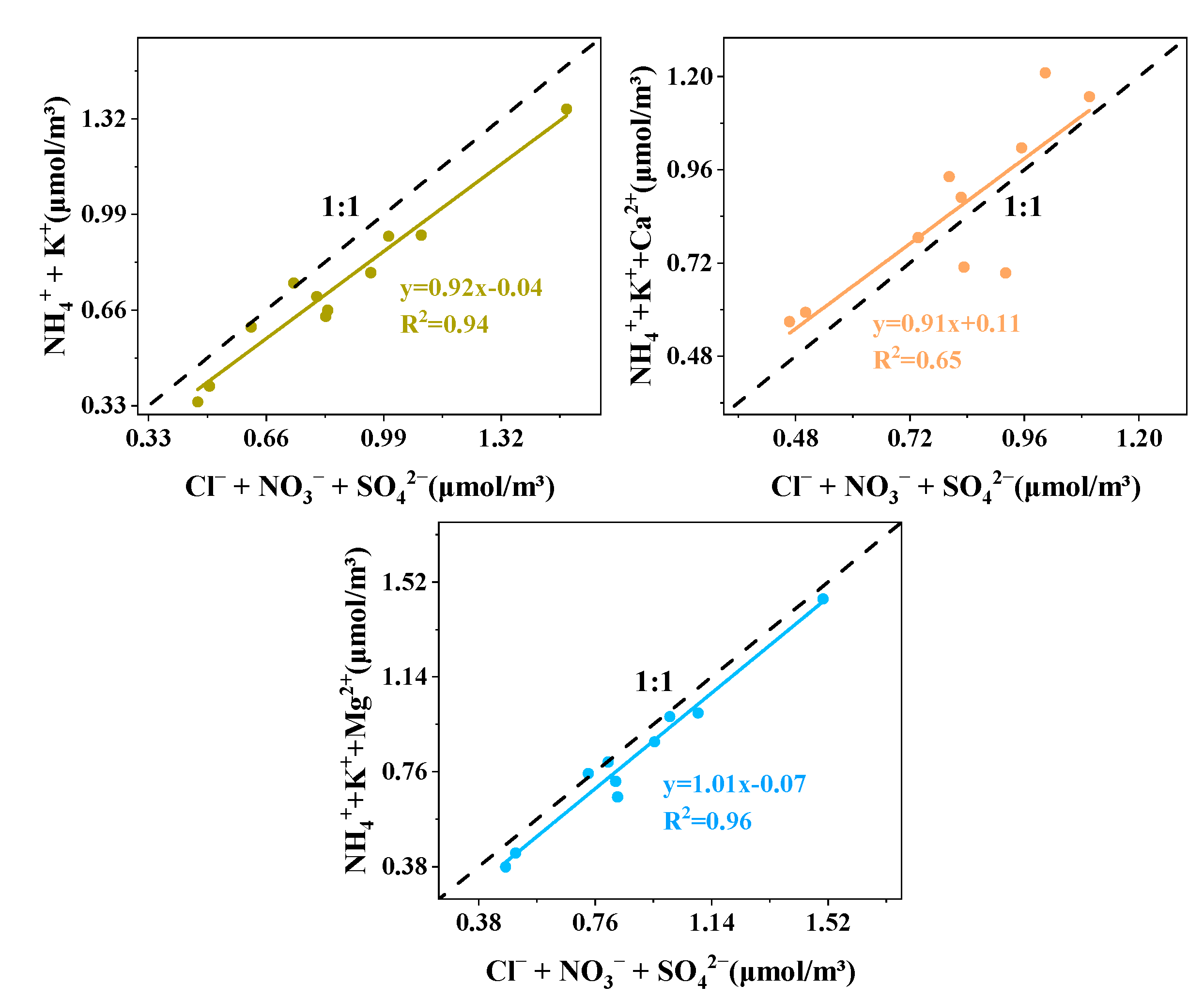

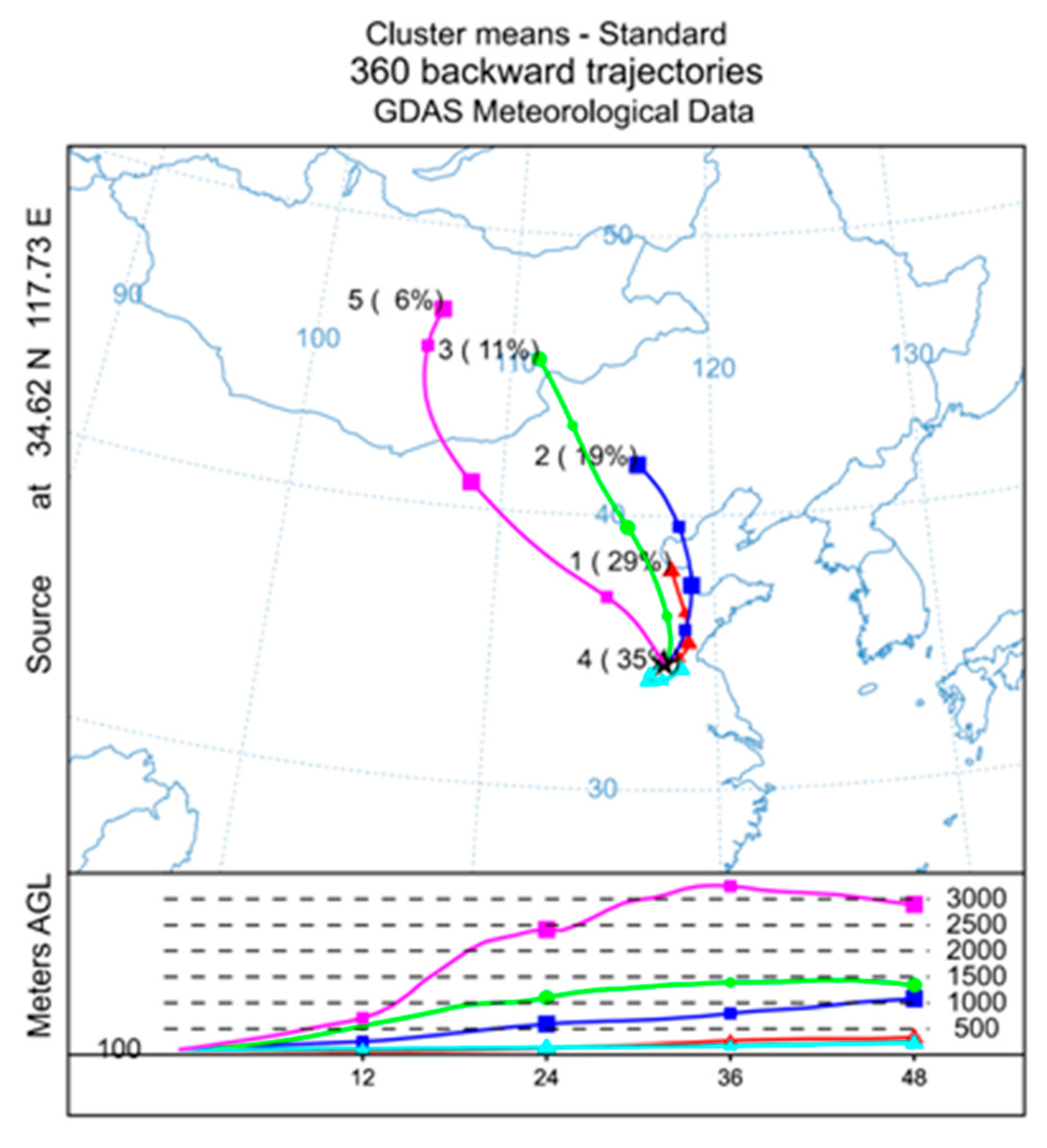
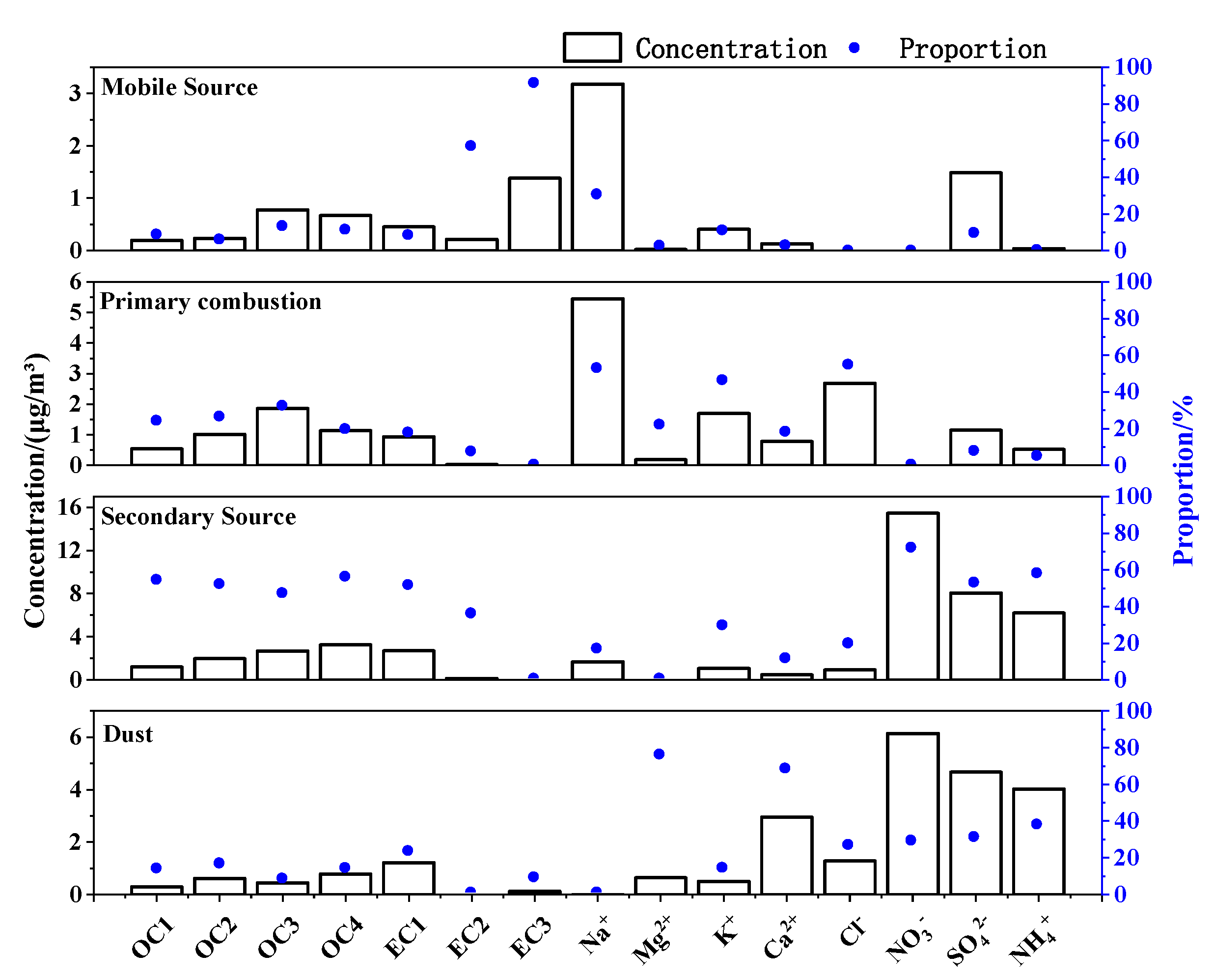
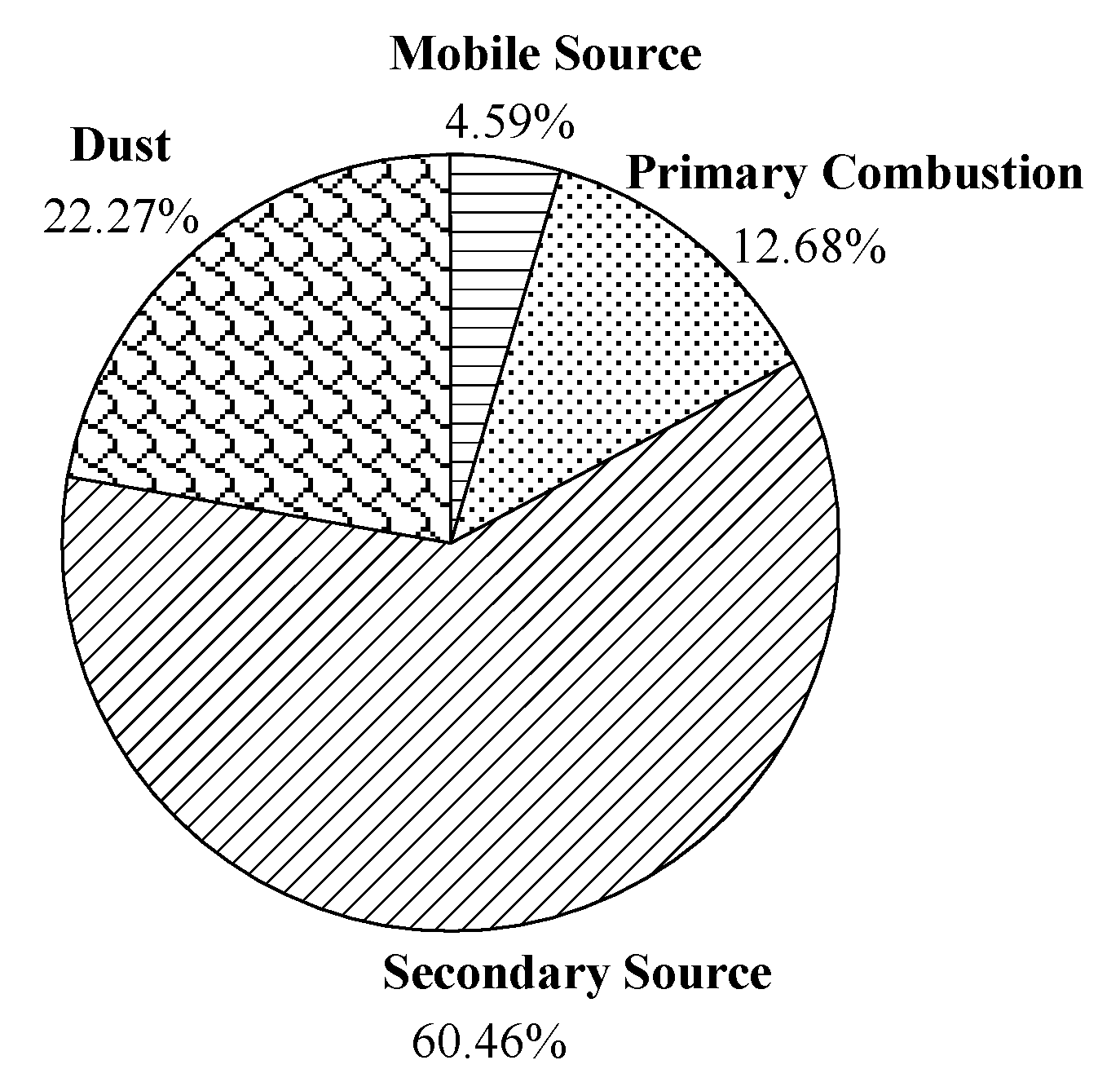
| MSOC | WSOC | SOC | POC | |
|---|---|---|---|---|
| MSOC | 1 | |||
| WSOC | 0.911 ** | 1 | ||
| SOC | 0.896 ** | 0.807 ** | 1 | |
| POC | 0.418 | 0.527 * | 0.075 | 1 |
| Location | Sampling Time | Component | Concentration (μg·m−3) | Proportion (%) | Reference |
|---|---|---|---|---|---|
| Beijing | 7 December 2011–31 December 2011 | WSOC | 8.15 | 40% | [28] |
| MSOC | 17.54 | 85% | |||
| Kathmandu | 12 April 2012–20 May 2014 | WSOC | 1.66 | 55% | [29] |
| Indo-Gangetic Plains | 8 November 2017–24 January 2018 | WSOC | 22.7 | 66% | [25] |
| Kathmandu Valley | April 2013–January 2018 | WSOC | 17.4 | 50% | [30] |
| Xi’an | 15 November 2018–15 December 2018 | WSOC | 8.9 | 58% | [31] |
| MSOC | 14.4 | 79% |
| Location | Sampling Site Type | Sampling Time | Season | Proportion (%) | Reference |
|---|---|---|---|---|---|
| A village in Shandong | rural | 27 January 2022–10 February 2022 | Winter | 47.48% | This study |
| Beijing | urban area | 4 December 2006–27 December 2006 | Winter | 51% | [32] |
| Taiyuan | urban area | 2009–2010 | Winter | 46.09% | [33] |
| Shenzhen | suburban | November 2009–December 2010 | Winter | 53.10% | [34] |
Publisher’s Note: MDPI stays neutral with regard to jurisdictional claims in published maps and institutional affiliations. |
© 2022 by the authors. Licensee MDPI, Basel, Switzerland. This article is an open access article distributed under the terms and conditions of the Creative Commons Attribution (CC BY) license (https://creativecommons.org/licenses/by/4.0/).
Share and Cite
Zou, C.; Wang, J.; Hu, K.; Li, J.; Yu, C.; Zhu, F.; Huang, H. Distribution Characteristics and Source Apportionment of Winter Carbonaceous Aerosols in a Rural Area in Shandong, China. Atmosphere 2022, 13, 1858. https://doi.org/10.3390/atmos13111858
Zou C, Wang J, Hu K, Li J, Yu C, Zhu F, Huang H. Distribution Characteristics and Source Apportionment of Winter Carbonaceous Aerosols in a Rural Area in Shandong, China. Atmosphere. 2022; 13(11):1858. https://doi.org/10.3390/atmos13111858
Chicago/Turabian StyleZou, Changwei, Jiayi Wang, Kuanyun Hu, Jianlong Li, Chenglong Yu, Fangxu Zhu, and Hong Huang. 2022. "Distribution Characteristics and Source Apportionment of Winter Carbonaceous Aerosols in a Rural Area in Shandong, China" Atmosphere 13, no. 11: 1858. https://doi.org/10.3390/atmos13111858
APA StyleZou, C., Wang, J., Hu, K., Li, J., Yu, C., Zhu, F., & Huang, H. (2022). Distribution Characteristics and Source Apportionment of Winter Carbonaceous Aerosols in a Rural Area in Shandong, China. Atmosphere, 13(11), 1858. https://doi.org/10.3390/atmos13111858








